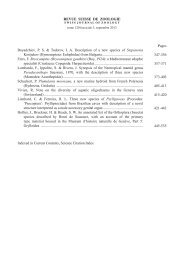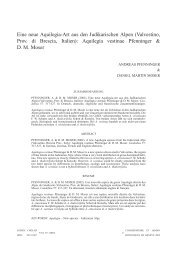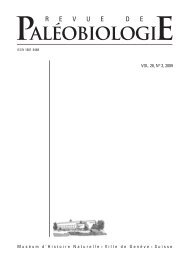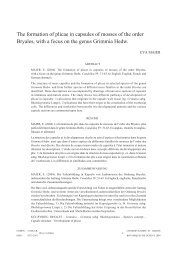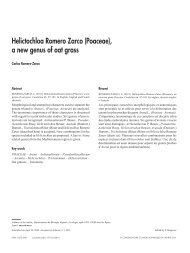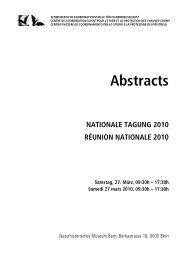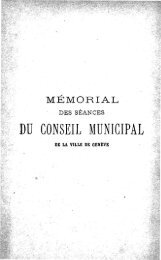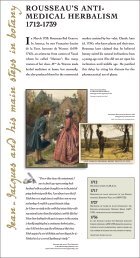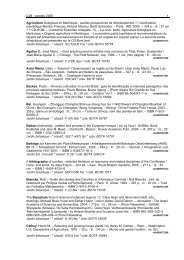Candolle's Prodromus: the role of father and son in relation to ...
Candolle's Prodromus: the role of father and son in relation to ...
Candolle's Prodromus: the role of father and son in relation to ...
You also want an ePaper? Increase the reach of your titles
YUMPU automatically turns print PDFs into web optimized ePapers that Google loves.
290 – C<strong>and</strong>ollea 64, 2009<br />
Introduction<br />
Accord<strong>in</strong>g <strong>to</strong> CANDOLLE (1873: 313), a <strong>to</strong>tal <strong>of</strong> 58975<br />
species were published <strong>in</strong> <strong>the</strong> multi-volumed <strong>and</strong> multiauthored<br />
<strong>Prodromus</strong> systematis naturalis regni vegetabilis –<br />
11790 as new <strong>and</strong> 47185 as exist<strong>in</strong>g names. About 26000 <strong>of</strong><br />
<strong>the</strong>se, <strong>in</strong>clud<strong>in</strong>g varieties, are <strong>in</strong>corporated <strong>in</strong> <strong>the</strong> International<br />
Plant Name Index (IPNI). Whereas it is easy <strong>to</strong> import IPNI<br />
names occurr<strong>in</strong>g <strong>in</strong> <strong>the</strong> <strong>Prodromus</strong> <strong>in</strong><strong>to</strong> a database for scrut<strong>in</strong>y<br />
(we used “Botanical Research And Herbarium Management<br />
System (Brahms)”), <strong>the</strong> data cannot be queried with confidence<br />
because basionym authors are not consistently <strong>in</strong>dicated <strong>and</strong><br />
because one <strong>of</strong> <strong>the</strong> ma<strong>in</strong> <strong>in</strong>dices that constitutes <strong>the</strong> IPNI, Index<br />
Kewensis, only recorded <strong>in</strong>fraspecific names from 1971. The<br />
ca. 2600 varieties <strong>in</strong> IPNI perta<strong>in</strong><strong>in</strong>g <strong>to</strong> <strong>the</strong> <strong>Prodromus</strong> are due<br />
<strong>to</strong> records obta<strong>in</strong>ed from <strong>the</strong> Gray Card Index (New World<br />
names) <strong>and</strong> <strong>the</strong> Australian Plant Names Index imply<strong>in</strong>g that<br />
some <strong>in</strong>fraspecific names <strong>in</strong> <strong>the</strong> <strong>Prodromus</strong> have undoubtedly<br />
been missed.<br />
August<strong>in</strong> Pyramus de C<strong>and</strong>olle (DC.) edited <strong>the</strong> multiauthored<br />
volumes 1-7 <strong>and</strong> also contributed <strong>to</strong> a number <strong>of</strong><br />
families as sole author. After DC.’s death <strong>in</strong> 1841, his <strong>son</strong>,<br />
Alphonse Louis Pierre Pyramus de C<strong>and</strong>olle (A. DC.), edited<br />
volumes 8-17, which were also multi-authored. In <strong>the</strong>se volumes<br />
<strong>the</strong>re are posthumous contributions by DC. as well as<br />
contributions by A. DC. as sole author. With <strong>the</strong> limitations <strong>in</strong><br />
<strong>the</strong> IPNI data mentioned above <strong>in</strong> m<strong>in</strong>d, at least 12760 names<br />
<strong>of</strong> species are attributable <strong>to</strong> DC. as basionym or publish<strong>in</strong>g<br />
author – clearly, an immense contribution. This led BUEK<br />
(1842: [iii]) <strong>to</strong> what can best be described as a religious experience,<br />
for follow<strong>in</strong>g <strong>the</strong> title page, he all but sanctifies DC.:<br />
“Botanicis quibuscunque, memoriam beati A.P. Dec<strong>and</strong>olle<br />
pio gra<strong>to</strong>que animo colentibus hocce opusculum”[This small<br />
work is dedicated <strong>to</strong> all botanists honor<strong>in</strong>g <strong>the</strong> memory <strong>of</strong> <strong>the</strong><br />
blessed A. P. Dec<strong>and</strong>olle with devotion <strong>and</strong> gratitude]. At least<br />
1800 names have A. DC. as basionym or publish<strong>in</strong>g author. In<br />
a similar manner, BUEK (1858: [iii]) dedicated <strong>the</strong> <strong>in</strong>dex <strong>to</strong> <strong>the</strong><br />
<strong>Prodromus</strong> volumes 7(2)-13 <strong>to</strong> Alphonse de C<strong>and</strong>olle: “Viro<br />
doctissimo, clarissimo, experientissimo, Alphonso Dec<strong>and</strong>olle,<br />
patris celeberrimi filio haud m<strong>in</strong>us celebri, de scientia botanica<br />
meritissimo hocce opusculum” [This small work is dedicated<br />
<strong>to</strong> <strong>the</strong> highly learned, famous <strong>and</strong> experienced Alphonse<br />
Dec<strong>and</strong>olle, not less renowned <strong>son</strong> <strong>of</strong> a highly renowned fa<strong>the</strong>r,<br />
outst<strong>and</strong><strong>in</strong>g servant <strong>of</strong> <strong>the</strong> botanical science]. The gr<strong>and</strong><strong>son</strong>,<br />
Anne Casimir Pyramus de C<strong>and</strong>olle (C. DC.) also contributed<br />
about 570 new names or comb<strong>in</strong>ations <strong>to</strong> volume 16 (<strong>in</strong> <strong>the</strong><br />
Jugl<strong>and</strong>aceae, Myricaceae <strong>and</strong> Piperaceae) – this latter work<br />
did not generate any comment by Buek.<br />
The Borrag<strong>in</strong>eae<br />
The Borag<strong>in</strong>aceae (Borrag<strong>in</strong>eae) are discussed <strong>in</strong> volumes<br />
9 <strong>and</strong> 10, published <strong>in</strong> 1845 <strong>and</strong> 1846 respectively. The family<br />
description <strong>in</strong> volume 9 is followed by a “Conspectus ord<strong>in</strong>is”<br />
on page 467 – an elucidation <strong>of</strong> <strong>the</strong> division <strong>of</strong> <strong>the</strong> family<br />
<strong>in</strong><strong>to</strong> four tribes: 1. Cordieae, 2. Ehretieae, 3. Heliotropeae,<br />
4. Borrageae. The latter is fur<strong>the</strong>r divided <strong>in</strong><strong>to</strong> six subtribes.<br />
Volume 9 <strong>the</strong>n goes on <strong>to</strong> discuss tribes 1-3. The authorship<br />
<strong>of</strong> this work is attributed <strong>to</strong> DC.– <strong>the</strong> runn<strong>in</strong>g header <strong>in</strong> <strong>the</strong><br />
volume stat<strong>in</strong>g “(auc<strong>to</strong>r DC.)” <strong>and</strong> <strong>the</strong> footnote provided by<br />
A. DC. allud<strong>in</strong>g <strong>to</strong> this fact (this work was <strong>the</strong>refore completed<br />
before DC.’s death <strong>in</strong> 1841). A. DC. does, however, add<br />
numerous comments <strong>to</strong> his fa<strong>the</strong>r’s work as footnotes throughout<br />
<strong>and</strong> also supplies <strong>the</strong> “Addenda et Corrigenda” for <strong>the</strong><br />
Borrag<strong>in</strong>eae at <strong>the</strong> end <strong>of</strong> volume 9.<br />
Volume 10 conta<strong>in</strong>s <strong>the</strong> tribe Borrageae. On page 1, footnote<br />
1, <strong>of</strong> this work, A. DC. <strong>in</strong>forms <strong>the</strong> reader that <strong>the</strong> work<br />
on <strong>the</strong> Borrageae was started by DC. <strong>in</strong> 1840, but that a large<br />
amount <strong>of</strong> work was left unf<strong>in</strong>ished (due <strong>to</strong> his death <strong>in</strong> 1841).<br />
A. DC. reports that he carefully re-exam<strong>in</strong>ed everyth<strong>in</strong>g,<br />
<strong>in</strong>clud<strong>in</strong>g dist<strong>in</strong>guish<strong>in</strong>g characters, <strong>and</strong> as a result reduced <strong>the</strong><br />
number <strong>of</strong> Borrageae subtribes from six (as proposed by DC.<br />
<strong>in</strong> volume 9) <strong>to</strong> five, <strong>in</strong> addition <strong>to</strong> recognis<strong>in</strong>g a few more<br />
genera <strong>and</strong> numerous additional species. The conspectus <strong>of</strong><br />
<strong>the</strong> five subtribes (Cer<strong>in</strong><strong>the</strong>ae, Echieae, Anchuseae, Lithospermeae<br />
<strong>and</strong> Cynoglosseae) <strong>in</strong> volume 10 are <strong>the</strong>refore<br />
authored by A. DC. (cf. page 1, footnote 4). However, DC.<br />
authored <strong>the</strong> entire Cer<strong>in</strong><strong>the</strong>ae <strong>and</strong> large parts <strong>of</strong> <strong>the</strong><br />
Anchuseae, Lithospermae <strong>and</strong> Cynoglosseae. A. DC.’s ma<strong>in</strong><br />
<strong>in</strong>put here appears <strong>to</strong> be recognis<strong>in</strong>g subdivisions with<strong>in</strong> genera,<br />
although more comprehensive generic contributions are<br />
<strong>in</strong>terspersed throughout, e.g. Alkanna Tausch (cf. page 97).<br />
In <strong>the</strong> case <strong>of</strong> <strong>the</strong> Echieae, Lobostemon Lehm. is reported <strong>in</strong><br />
<strong>the</strong> <strong>Prodromus</strong> <strong>to</strong> be authored by both DC. <strong>and</strong> A. DC. The<br />
follow<strong>in</strong>g genus, Echium L., is divided <strong>in</strong><strong>to</strong> three sections: 1.<br />
Trichobasis, 2. Synlobus, 3. Euechium. Sections 1-2 are<br />
authored by DC. & A. DC. <strong>and</strong> section 3 solely by DC.<br />
Section Trichobasis conta<strong>in</strong> eight names now all <strong>in</strong>cluded <strong>in</strong><br />
Echiostachys Levyns (LEVYNS, 1934), once belong<strong>in</strong>g <strong>to</strong>, but<br />
now considered sister <strong>to</strong> Lobostemon (BUYS, 2000; RETIEF &<br />
BUYS, 2000). Section Synlobus conta<strong>in</strong>s three names, now all<br />
<strong>in</strong>cluded <strong>in</strong> Lobostemon. Section Euechium conta<strong>in</strong>s what is<br />
considered <strong>to</strong> be true Echium. This implies that <strong>in</strong> <strong>the</strong> context<br />
<strong>of</strong> Lobostemon (<strong>and</strong> Echiostachys), all new names or comb<strong>in</strong>ations<br />
appear<strong>in</strong>g <strong>in</strong> <strong>the</strong> <strong>Prodromus</strong> <strong>of</strong> C<strong>and</strong>olle must be<br />
authored as “DC. & A. DC.”, <strong>in</strong> contrast <strong>to</strong> what is reported<br />
<strong>in</strong> STAFLEU & COWAN (1976) <strong>and</strong> databases such as IPNI,<br />
TROPICOS, PRECIS, etc.




